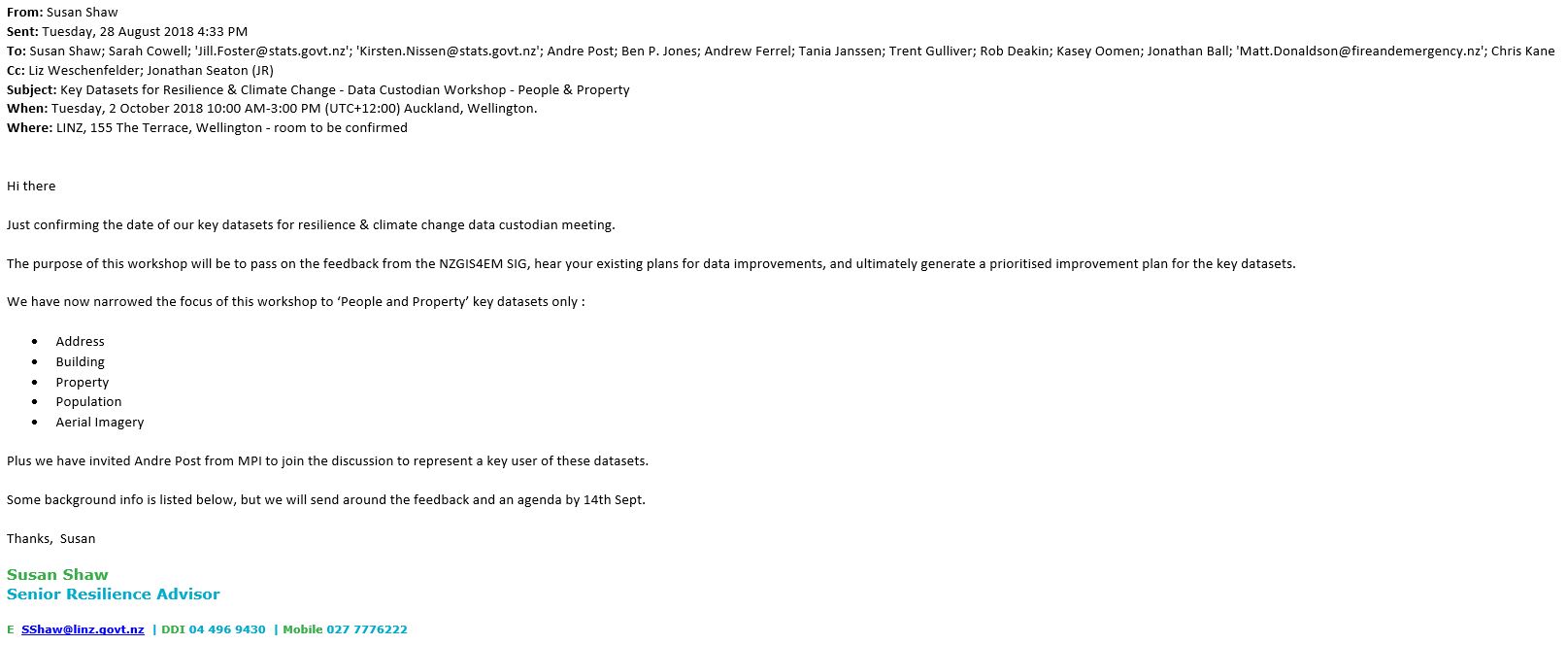
ACT
UNDER
INFORMATION
RELEASED
OFFICIAL
THE
 From:
Susan Shaw
To:
Sarah Cowell; "[email address]"
From:
Susan Shaw
To:
Sarah Cowell; "[email address]";
"[email address]";
"[email address]"; "Andre Post";
Andrew Ferrel; Ben P. Jones;
Chris Kane; Jonathan
Ball;
Tania Janssen; Trent Gulliver
Cc:
Rob Deakin; Kasey Oomen; Liz Weschenfelder
Subject:
Key Datasets for Resilience & Climate Change - People & Property Data Custodian Workshop
Date:
Friday, 28 September 2018 2:51:00 PM
Attachments:
Key Datasets for Resilience - Improvement Plans - September 2018.docx
image002.png
image003.png
Hi there
We are looking forward to working with you next Tuesday 2nd October,
on the Key Datasets for Resilience and Climate Change.
The workshop will run from 10am until 3pm, and the proposed agenda is set
out at the end of this email.
ACT
Please find attached an update improvement plan, which now includes all
datasets to be discussed.
Where to find us:
The workshop will be held in the LINZ offices at 155 The Terrace, Wellington.
UNDER
As you enter Radio New Zealand House on the ground floor, walk straight ahead to the “Argest”
doorway. Hoki is the third meeting room on the right.
Background:
LINZ has identified 12 key dataset groups which are important for Resilience & Climate Change,
INFORMATION
based on People, Property, Transport, Rivers and Topography.
The purpose of this workshop is to bring together data custodians from the public sector, with a
focus on People, Building, Address, Suburbs, Property and Aerial Photography.
RELEASED
For each of the key datasets, we propose starting with a five minute update from the data
custodian on current work plans.
We will then look at the feedback collated to date, to start our discussion on potential data
improvements – see attached
OFFICIAL
· Who is the appropriate data custodian?
· Are the suggested improvements valid and correct?
·
THE
Are users aware of the latest developments?
· What might be achievable from the suggested improvements?
· What are the barriers, if not?
· What needs to happen next?
We are pleased to have André Post, from Ministry for Primary Industries (MPI) attending, to
represent user requirements during our discussions.
Ultimately, our aim is to agree and implement an improvement plan for each dataset. However,
the aim of this workshop is to consider the user feedback received to date and agree our next
steps.
We look forward to seeing you next Tuesday .
Thanks, Susan
Proposed Agenda:
10:00 - 15:00
10:00 Welcome
ACT
10:10 Introduction to agenda
10:15 Go Round
10:30 LINZ Resilience Team update
10:40 Key user perspective - Ministry for Primary Industries - why data is important to
their work and key data issues. (André)
UNDER
10:50 LINZ Topo Team update (Andrew)
10:55 Aerial Photography data improvements
11:15 Break
INFORMATION
11:30 LINZ Addressing Team update (Trent)
11:35 Addressing data improvements
RELEASED
12:00 FENZ update (Matt)
12:05 Suburbs
12:30 LunchOFFICIAL
13:00 Stats NZ update (Sarah)
13:05 Census data improvements
THE
13:25 LINZ Topo Team update (Ben)
13:30 Building data improvements
13:50 LINZ IPS Team update (Chris)
13:55 Property data improvements
14:15 Break

14:30 Summarise findings and next steps
14:45 Final go round
15:00 Close
Susan Shaw
Senior Resilience Advisor
E
[email address] | DDI 04 496 9430 | Mobile 027 7776222
Wellington Office, Level 7, Radio New Zealand House, 155 The Terrace
PO Box 5501, Wellington 6145, New Zealand | T 04 460 0110
W
www.linz.govt.nz |
data.linz.govt.nz
ACT
UNDER
INFORMATION
RELEASED
OFFICIAL
THE
 Draft Improvement Plans for Key Datasets for Resilience & Climate Change
Background
Draft Improvement Plans for Key Datasets for Resilience & Climate Change
Background
LINZ has identified three key challenges where LINZ can make a significant contribution to the big
picture and support New Zealand Inc. The key challenges are water, urban areas and resilience and
climate change. The focus of this document is to support efforts to prepare for, mitigate and adapt to
the impacts on land and sea of climate change and one-off events.
LINZ has identified 12 key datasets groups which are important to support the work of resilience and
climate change:
People & Property:
Address, Building, Property, Population
ACT
Transport:
Road and Rail Network
Rivers:
River Network and Water Catchment Boundaries
Topography:
Elevation, Coastline, Aerial Photography and Topo Maps
Issues with these key datasets have been collated from the resilience community. LINZ facilitated a key
dataset workshop as part of the NZGIS4EM Special Interest Group in August 2018, and feedback has also
been sought via interviews with key users. This feedback has been used to prepare the draft data
improvement plans set out in this document.
UNDER
Key Data Workshops
It is proposed to run a series of workshops with the data custodians of these key datasets to share the
data issues raised and draft an improvement plan. These improvement plans wil then be shared with
key users for review and then confirmed with the data custodians.
INFORMATION
The three workshops wil be
People & Property
Custodians:
Stats NZ, LINZ, Fire Emergency NZ, Councils
`
Key User:
Ministry for Primary Industries
RELEASED
Date:
2 October 2018
Transport & Topography
Custodians:
NZ Transport Agency, KiwiRail, Ministry of Transport,
LINZ, Councils
Key User:
North Canterbury Transport Infrastructure Recovery
OFFICIAL (NCTIR)
Date:
19 September 2018
Rivers & Coasts
Custodians:
LINZ, NIWA, GNS, Councils
Key User:
Marlborough District Council
THE
Date:
16 October 2018
28 September 2018
Page 1 of 17

ACT
UNDER
INFORMATION
RELEASED
OFFICIAL
THE
28 September 2018
Page 2 of 17
 Suggestons for general improvements
Suggestons for general improvements
1. Make it easier to identify key datasets for resilience & climate change on data.govt.nz
2. Add geospatial dataset search to data.govt.nz
3. Set up functionality to enable the regular download and updates of key datasets for resilience for a
Council, for a wider region and for New Zealand to enable easy access to date if internet access were
not available.
4. Run workshops on key datasets so resilience community can make the most of the available data.
5. Offer call centre assistance, or live chat similar to the Stats NZ website, on key data issues and ACT
standards
UNDER
INFORMATION
RELEASED
OFFICIAL
THE
28 September 2018
Page 3 of 17

 People & Property: Address
People & Property: Address
Datasets
• NZ Street Address
Custodian
Land Information New Zealand (LINZ) –Addressing Team
Use Case
Risk – estimate how many people are within a tsunami evacuation zone
Readiness - which addresses are outside travel distance to a Civil Defence Centre
Response – which addresses need to be searched immediately after an event
Recovery - which addresses need to be demolished after a serious event
ACT
Climate Change - which addresses are susceptible to sea level rise, flooding,
inundation and tsunami
Data Issues
Good Practice
A national register of addresses is already established, including a known
maintenance programme, and established relationships with local authorities.
Data is available under Creative Commons licence
Source
Multiple data sources reported including LINZ, Councils, CoreLogic, Esri GeoCoder,
UNDER
which means there is no clear single source of truth for a national dataset.
Coverage
National coverage exists, but data quality, including currency, consistency and
completeness, is variable.
Attribution
There is no persistent, unique ID for an address
INFORMATION
Addresses are not associated with a building ID, to help a user identify a building
There is no useful attribute to enable a user to quickly filter the data for a region.
Limitations
Addresses are collected for different purposes, which creates limitations of use
during an emergency event.
RELEASED
LINZ Addressing datasets currently only includes addresses allocated by local
authorities. Local authorities do not collect addresses in a consistent way. For
example addresses may be captured for rating purposes only, but need to take
account of other addresses in use for example for library membership, dog
OFFICIAL
registration and shops.
Different response organisations referencing different address datasets. For
example Emergency Services use CoreLogic which includes unallocated addresses.
THE Addresses do not accurately represent individual buildings, for example a hospital
campus may have multiple buildings represented by a single address point.
Is the correct location of a farm address the farm house, the centre of the farm or
the entrance to the farm?
28 September 2018
Page 4 of 17

Colloquial names used in an emergency response are not included in the address
dataset, which makes it difficult to geocode data, especially in rural areas.
Accessibility
Data is not published as an Esri REST service on LINZ Data Service
Data is not discoverable as an OGC WFS service on data.govt.nz
Data is not discoverable as an Esri REST service from data.govt.nz
Maintenance
There is concern about the consistency between the local and national data.
Metadata
118 total entries on data.govt.nz for address
55 entries on data.govt.nz for address by LINZ and 12 for Stats NZ
Improvements
ACT
Suggested
1. Work required to ensure national addressing data aligns with Councils data.
Improvements
2. Work with Councils to confirm LINZ as single source of truth, and to promote
and explain reasons for a consistent approach to the recording of an address.
3. LINZ to improve the national dataset by adding known unallocated addresses.
4. Assign a persistent, unique ID to each address
UNDER
5. Assign a building ID to each address
6. Add two attributes for Regional / Unitary and Territorial Councils to enable
the easy filtering of data for both download and webservice.
7. Publish address as Esri webservice on LINZ Data Service
INFORMATION
List data as an OGC WFS and Esri REST service on data.govt.nz
8. Tag as key dataset for resilience on data.govt.nz and LINZ Data Service
RELEASED
Business Case
Business Case to be discussed at workshop
Barriers
Barriers to be discussed at workshop
Priority
Methodology and criteria to be defined
OFFICIAL
Timeframes
Timeframes to be defined
Agreed Improvement Plan
Agreed
Improvements
To be confirmed
THE
Agreed Timeline
To be confirmed
28 September 2018
Page 5 of 17

 People & Property: Suburbs
People & Property: Suburbs
Datasets
• NZ Localities Suburbs
Custodian
Fire & Emergency New Zealand (FENZ)
Use Case
Risk – which communities are at risk from a tsunami event
Readiness - which communities are likely to be isolated after a landslide event
Response – quickly identify the location of a person requiring emergency support
Recovery - which communities require additional funding for economic
regeneration after an event
ACT
Climate Change - which communities are susceptible to sea level rise, flooding,
inundation and tsunami
Data Issues
Good Practice
Suburbs dataset is created and maintained based on a practical requirement to
respond to emergency events.
Names extend beyond addresses to include islands and bays, which provide more
UNDER
options for identifying a person in distress.
Source
Fire and Emergency NZ is the only source for this data.
Coverage
Complete national coverage
Attribution
Not all localities are associated with a city name or major name, making it difficult
to filter and search data.
INFORMATION
Lakes form part of the suburb boundary, which makes it difficult to use the data
for analysis reporting.
There is no useful attribute to enable a user to quickly filter the data for a specific
RELEASED
region.
Data Dictionary is not easily accessible
Limitations
Key limitation is with data accessibility, particularly for a civil defence emergency
management response.
OFFICIAL
Accessibility
Data is not openly available under Creative Commons Licence
Data is not discoverable on data.govt.nz
Data is not discoverable as an OGC WFS service on data.govt.nz
Data is not discoverable as an Esri REST service from data.govt.nz
THE
Maintenance
Routine update programme is not published
Metadata
2 entries on data.govt.nz for suburbs, both from Wel ington City Council
28 September 2018
Page 6 of 17

Improvements
Suggested
1. Associated all localities with a city name or major name to enable easier data
Improvements
analysis.
2. Remove lakes from suburb and locality boundaries, and maintain lakes as a
separate dataset.
3. Add two attributes for Regional / Unitary and Territorial Councils to enable
the easy filtering of data for both download and webservice.
4. Make suburbs available under a Creative Commons licence.
5. Publish suburbs as an Esri webservice
ACT
6. List suburbs as an OGC WFS and Esri REST service on data.govt.nz
7. Tag as key dataset for resilience on data.govt.nz
8. Expand metadata to include known routine update programme and publish
Data Dictionary
Business Case
Business Case to be discussed at workshop
UNDER
Barriers
Barriers to be discussed at workshop
Priority
Methodology and criteria to be defined
Timeframes
Timeframes to be defined
Agreed Improvement Plan
INFORMATION
Agreed
Improvements
To be confirmed
Agreed Timeline
To be confirmed
RELEASED
OFFICIAL
THE
28 September 2018
Page 7 of 17

 People & Property: Buildings
People & Property: Buildings
Datasets
• NZ Building Outlines (Pilot) – LINZ
• Building Outlines – Individual maintained by territorial and unitary authorities
Custodian
Land Information New Zealand (LINZ) -Topography Team
Use Case
Risk - what is the value, use, height, age, construction type and occupancy of the
building to estimate potential loss
Readiness - which buildings are on land subject to Section 72 of Building Act -
natural hazards
Response – complete a Rapid Impact Assessment for every building in the ACT
affected area within 8 to 48 hours of an event.
Recovery - which buildings are damaged and have Section 124 of Building Act
applied - no access
Climate Change - which building are susceptible to sea level rise, flooding,
inundation and tsunami
Data Issues
UNDER
Good Practice
Building outlines have been created as an independent dataset, taking into
account the potential value of the data to NZ Inc, and thinking more widely than
simply a product requirement for Topo Maps.
Data is available under Creative Commons licence
Source
Multiple data sources reported including LINZ, Councils and CoreLogic, which
means there is no single source of truth for a national dataset.
INFORMATION
Coverage
No complete national coverage
Attribution
Buildings do not have a persistent, unique ID, to create a shared identity
RELEASED
Buildings are not associated with an address, to help a user identify a building
Buildings do not have a use attribute, particularly to define residential to help
inform a response
OFFICIAL
Buildings do not have a height, or flood threshold level, for modelling natural
hazard risks
Buildings do not have a criticality attribute, for example earthquake prone
buildings, CDEM buildings
THE Buildings do not identify specific uses eg government owned building, required for
potential CDEM facility or to house govt employees
There is no attribute to quickly filter the data for a specific region.
28 September 2018
Page 8 of 17

Data Dictionary is not available
Limitations
Buildings do not adequately represent multistorey buildings or shops
Accessibility
Data is not published as an Esri REST service on LINZ Data Service
Data is not discoverable as an OGC WFS service on data.govt.nz
Data is not discoverable as an Esri REST service from data.govt.nz
Maintenance
Buildings are updated as part of aerial photography update, which means the
national dataset is only current to the latest aerial imagery
Routine update programme is not planned
Metadata
143 total entries on data.govt.nz for building
ACT
56 entries on data.govt.nz for building by LINZ
UNDER
INFORMATION
RELEASED
OFFICIAL
THE
28 September 2018
Page 9 of 17

Improvements
Suggested
1. Work required to ensure national building data aligns with Councils data.
Improvements
Work with Councils to confirm LINZ as single source of truth.
2. Councils may be updating data outside of aerial photography updates.
Develop a process to enable updates to be incorporated into the national
dataset.
3. Provide complete national coverage
4. Maintain a persistent, unique ID for each building
5. Assign an address to each building - need to agree which address eg on corner
ACT
or campus
6. Assign a height estimate to each building and indication of number of floors.
Need to know which height level to assign and a process to estimate number
of floors. Talk more with Riskscape.
7. Add two attributes for Regional / Unitary and Territorial Councils to enable
the easy filtering of data for both download and webservice.
UNDER
8. Set attribute standards, for example to record earthquake prone buildings, to
enable consistent national data, then allow Council's to improve this data and
feed back into building updates.
9. Publish buildings as Esri webservice on LINZ Data Service
List data as an OGC WFS and Esri REST service on data.govt.nz
INFORMATION
10. Tag as key dataset for resilience on data.govt.nz and LINZ Data Service
11. Expand metadata to include known routine update programme and publish
Data Dictionary
RELEASED
Business Case
Business Case to be discussed at workshop
Barriers
Barriers to be discussed at workshop
Priority
Methodology and criteria to be defined
OFFICIAL
Timeframes
Timeframes to be defined
Agreed Improvement Plan
Agreed THE
Improvements
To be confirmed
Agreed Timeline
To be confirmed
28 September 2018
Page 10 of 17

ACT
UNDER
INFORMATION
RELEASED
OFFICIAL
THE
28 September 2018
Page 11 of 17

 People & Property: Property
People & Property: Property
Datasets
• NZ Parcels
Custodian
Land Information New Zealand (LINZ)
Land Registry / Integrated Property Services Team
Use Case
Risk – which properties are at risk from a tsunami event
Readiness - which properties are likely to be isolated after a landslide event
Response - how many properties need to be searched within 48 hours after an
event
ACT
Recovery - which properties are damaged and have Section 124 of Building Act
applied - no access
Climate Change - which properties are susceptible to sea level rise, flooding,
inundation and tsunami
Data Issues
Good Practice
A national dataset for parcels is in place and is well maintained.
UNDER
Parcel data is available under Creative Commons licence
Source
LINZ is recognised as single source of truth for the national parcel dataset, but
property data is also sourced from CoreLogic, Property Guru and Google Maps.
Coverage
Complete national coverage of parcels exists
Attribution
Multiple landowners cannot be recorded against a single parcel.
INFORMATION
Parcel dataset does not define a property.
A property can be defined from parcels, but requires access to the Valuation
Assessment data maintained by Councils.
RELEASED
Buildings are not associated with a parcel.
There is no useful attribute to enable a user to quickly filter the data for a specific
region.
OFFICIAL
Data Dictionary is not available
Limitations
All response organisations are required to process parcel information to join
parcels with the relevant attributes.
THE It is difficult to define a property is, and depends on the use case.
The majority of properties can be defined, but only with access to District
Valuation Roll data.
28 September 2018
Page 12 of 17

Some Councils generate revenue from the sale of District Valuation Roll data,
which is a barrier to opening up this data.
Accessibility
District Valuation Roll Audit Data is not openly available from Council
Parcel data is not published as an Esri REST service on LINZ Data Service
Parcel data is not discoverable as an OGC WFS service on data.govt.nz
Parcel Data is not discoverable as an Esri REST service from data.govt.nz
Maintenance
Parcels and District Valuation Roll data are well maintained, but are discrete
datasets.
Metadata
359 total entries on data.govt.nz for property
31 entries on data.govt.nz for property by LINZ (32 entries for parcel), 31 from
Landcare and 20 from Ministry for the Environment
ACT
Improvements
Suggested
1. Provide access to parcel information with all relevant attribution already
Improvements
associated in the layer table, NZParcels to be extended to include land owner,
Purpose, Legality, Statute (for non titled properties), Statutory Name, Maori
Name and Hydro Name which would be useful information in a response and
recovery.
2. Work with Local Authorities to open up access to the District Valuation Roll
UNDER
audit files, particularly for use in a cross regional emergency response and the
capture of Rapid Assessment information.
3. Associate each ParcelID with the relevant Valuation Assessment from the
District Valuation Roll to enable the creation of property boundaries, and the
identification of cross leases.
INFORMATION
4. Associate each ParcelID with the relevant Building ID to enable District
Valuation Roll data to be associated with the relevant building.
5. Enable multiple landowners to be associated with a parcel.
RELEASED
6. Add two attributes to parcels for Regional / Unitary and Territorial Councils to
enable the easy filtering of data for both download and webservice.
7. Publish parcels as Esri webservice on LINZ Data Service
List data as an OGC WFS and Esri REST service on data.govt.nz
OFFICIAL
8. Tag as key dataset for resilience on data.govt.nz and LINZ Data Service
Business Case
Business Case to be discussed at workshop
THE
Barriers
Barriers to be discussed at workshop
Priority
Methodology and criteria to be defined
Timeframes
Timeframes to be defined
28 September 2018
Page 13 of 17

 People & Property: Population
People & Property: Population
Datasets
• Meshblock 2013
• Census data
o Age by meshblock (2013 Census)
o Ethnic group by meshblock (2013 Census)
o Age and income in 2013 by TALB2013
o Population by meshblock (2013 Census)
o Sex by meshblock (2013 Census)
o DeprivationIndex 2013 Meshblock
o Status in employment
o Household income
o Religious affiliation
ACT
o Work and labour force status
Custodian
Stats NZ
Use Case
Risk – estimate number of people left isolated from services following a major
Alpine Fault rupture.
Readiness - identify vulnerable populations to better inform evacuation planning
UNDER
Response – estimate population counts to identify how many people need to be
evacuated and accommodated in a Civil Defence Centre.
Recovery – how many people have been displaced after a significant event, and
likely to require ongoing welfare support.
Climate Change – how many people are susceptible to sea level rise, flooding,
INFORMATION
inundation and tsunami
Data Issues
Good Practice
Stats NZ is seen as the preferred source of truth for population data.
Stats NZ is the lead agency for government-held data, with the Chief Executive
RELEASED
designated as the Government Chief Data Steward, and so is well placed to make
changes to improve the value of data.
Data is available under Creative Commons licence
Source
Multiple data sources reported including Stats NZ, Council Rates, Riskscape, Spark,
Paymark, Farms Online, Federated Farmers, SmartGrowth, Ministry of Social
OFFICIAL
Development, LINZ Buildings, which means there is no single source of truth for
current, national population data.
Coverage
Complete national coverage is available from Stats NZ, but dates back to 2013.
THE
Attribution
There is no useful attribute to enable a user to quickly filter the data for a specific
region.
Limitations
Population data is only available at meshblock level, which is particularly limiting
to help with an emergency event response and recovery. It is hard to extract
actionable knowledge from meshblock data.
28 September 2018
Page 14 of 17

Accessibility
Information is easier to access from other sources than from Stats NZ
Data is not published as an Esri REST service on Stats NZ Data Service
Data is not discoverable as an OGC WFS service on data.govt.nz
Data is not discoverable as an Esri REST service from data.govt.nz
Maintenance
Data is not uptodate as only the previous 2013 census data is available.
Updated data is not planned to be release until March 2019, 12 months after it
was collected. Population estimates for the current year are required for
response, plus long term population estimates for recovery and risk assessment.
Metadata
410 total entries on data.govt.nz for population
235 entries on data.govt.nz for population by Stats NZ
Improvements
ACT
Suggested
1. Provide more granular data than meshblock level to better inform decision
Improvements
making while continuing to adhere to privacy rights.
2. Make it easier to integrate population attribution, including age, ethnic group
and religion, to inform a response.
3. Make it easier to integrate population attribution data including gender,
UNDER
deprivation, employment status and income to inform a recovery.
4. Identify options for making basic population count information available
before March 2019.
5. Publish meshblock boundaries, plus more granular data, as Esri webservice on
Stats NZ Data Service
INFORMATION
List data as an OGC WFS and Esri REST service on data.govt.nz
6. Tag as key dataset for resilience on data.govt.nz
7. Expand metadata including publishing a Data Dictionary
RELEASED
Business Case
Business Case to be discussed at workshop
Barriers
Barriers to be discussed at workshop
Priority
Methodology and criteria to be defined
OFFICIAL
Timeframes
Timeframes to be defined
Agreed Improvement Plan
Agreed
Improvements
To be confirmed
THE
Agreed Timeline
To be confirmed
28 September 2018
Page 15 of 17

 Topography: Aerial Photography
Topography: Aerial Photography
Datasets
• NZ Aerial Imagery
Custodian
Land Information New Zealand (LINZ) -Topography Team
Use Case
Risk - what land change has happened when compared to historical aerial
photography
Readiness – where are the suburbs where land is subject to Section 72 of Building
Act - natural hazards
Response – help define the extent of the damage and provide context to ACT
situational awareness reports
Recovery – what is the pattern of buildings are damaged and have Section 124 of
Building Act applied - no access
Climate Change – what is the extent of sea level rise, flooding, inundation and
tsunami in a region
Data Issues
UNDER
Good Practice
LINZ is currently coordinating the capture of aerial photography, to an agreed
standard, to build a centralised dataset.
LINZ provides the facility to store aerial photography for Councils and make
available for re-use, removing significant overhead for each Council in the supply
of aerial photography data.
Data is available under Creative Commons licence
INFORMATION
Source
Multiple data sources reported including LINZ, Councils, CoreLogic, Eagle
Technology and Google. LINZ is recognised as the single source of truth for
national data custodianship, but not supply.
Coverage
Not quite complete national coverage
RELEASED
Attribution
No specific feedback on aerial photography index grid attribution
Limitations
Frequency of updates is limited to Council budgets.
Coordinate better continuity of capture between regions
OFFICIAL
Accessibility
Data is not published as an Esri REST service from LINZ Data Service
Data is not discoverable as an OGC service on data.govt.nz
Data is not discoverable as an Esri REST service from data.govt.nz
Maintenance
Routine update programme is not planned
THE
Metadata
438 total entries on data.govt.nz for aerial
319 entries on data.govt.nz for aerial by LINZ
28 September 2018
Page 16 of 17

Improvements
Suggested
Improvements
1. Confirm LINZ as single source of truth for national aerial photography
2. Publish aerial photography as a national basemap service, including large
scales.
3. Enable aerial photography captured during an event to be stood up as a single
service as quickly as possible, rather than feeding out as an ftp which all
agencies have to spend time processing.
4. Enable timely delivery of satellite imagery in an event
ACT
5. Provide complete national coverage of aerial photography – fill in the gaps
with satellite imagery
6. Provide advice on the best way to access and manage large datasets such as
aerial photography.
7. Tag as key dataset for resilience on data.govt.nz and LINZ Data Service
UNDER
8. Publish Data Dictionary
Business Case
Business Case to be discussed at workshop
Barriers
Barriers to be discussed at workshop
Priority
Methodology and criteria to be defined
Timeframes
Timeframes to be defined
INFORMATION
Agreed
Improvement Plan
Agreed
RELEASED
Improvements
To be confirmed
Agreed Timeline
To be confirmed
OFFICIAL
THE
28 September 2018
Page 17 of 17
Key Datasets for Resilience & Climate Change
People & Property Workshop - meeting notes
Date:
2 October 2018
Attendees:
Sarah Cowell, Jill Foster, & Kirsten Nissen, Stats NZ
Matt Donaldson, Fire & Emergency New Zealand (FENZ)
André Post & Jonathan Seaton, Ministry for Primary Industries (MPI)
Andrew Ferrel & Ben Jones, LINZ Topography Team
Tania Janssen & Chris Kane, LINZ Addressing Team
Jonathan Ball, LINZ Data Service Team
Rob Deakin, Susan Shaw & Kasey Oomen, LINZ Resilience Team
Apologies:
Trent Gul iver, LINZ Addressing Team
ACT
Purpose:
To discuss key datasets relating to people and property, which have been identified
as important for resilience and climate change. Share feedback from the NZGIS4EM
community with the public data custodians on how to improve these datasets.
Actions:
1. Susan to update improvement plans and agree with data custodians before sharing with
UNDER
NZGIS4EM community, ideally in November.
User Story
INFORMATION
Andre Post - Ministry for Primary Industries
Role of MPI is to protect and promote primary industries and trade, including biosecurity, food
safety standards and trade.
RELEASED
Being in response is business as usual for MPI, with 43 active responses at present. the response
phase. Resilience for MPI: readiness and surveillance, MPI led response (biosecurity, trade, food
safety), natural disaster response, possible long term management. MPI leads on animal disease,
MoH on human disease.
OFFICIAL
Data requirements MPI have:
- Response specific: collect and manage data, situational awareness (timely – now).
- General: reference data, common reference between agencies, common reference for
THE
public, situational awareness (base data).
FarmsOnLine – MPI software, restricted under the Biosecurity Act – only al owed to be used for
biosecurity.
*Key comments highlighted in red
1
Key Datasets for Resilience & Climate Change
People & Property Workshop - meeting notes
A few datasets MPI require under the key dataset groups are sourced from CoreLogic. A property
and a farm are not the same thing. Farm boundaries are very important for MPI regarding the
property group. See presentation for further details.
Questions:
Is community resilience a part of MPI’s function? Yes, MPI has a welfare function.
1. Dataset group: Aerial photography
Representative introduction: Andrew Ferrel - LINZ
In CHCH there was a need for imagery – LINZ disseminated this. LINZ started coordinating imagery
(with DoC and MPI for funding) and making it available openly; only 7% was available openly prior to
ACT
CHCH. Currently, LINZ makes sure that all organisations requiring it get it instantly for each update
i.e. Eagle, CoreLogic etc.
Discussion:
- We don’t want to be having to wait for a download during an event. We want data available
via download for preparedness in case we lose internet. MPI does have offline capability.
MPI wil require more bands than others as they require more detail, they use RGB.
UNDER
- Metadata and projection is very important – FENZ. MPI use WGS84 for fisheries etc, FENZ
use this for broader stuff beyond national – web mercator.
Actions:
LINZ to coordinate LiDAR & aerial imagery – most in agreement
INFORMATION
LINZ to provide imagery as a service (consensus agreement) – service needs to be resilient (up 99.9%
of the time), available as a REST service.
Issues:
RELEASED
LINZ to coordinate LiDAR & aerial imagery – concern regarding urgency and that capture is fit-for-
purpose.
Does everyone have satellites on their buildings? In case we lose internet.
OFFICIAL
2. Dataset group: Property
THE
Representative introduction: Chris Kane - LINZ
LINZ aim is to make information visible relating to NZ property; LINZ has much of this data but it’s
not connected; all of the data needs to be linked together. Ideal y, we want anyone to be able to
understand and access this data; Individual representations of property to be as visible and useable
as possible – first aim
*Key comments highlighted in red
2
Key Datasets for Resilience & Climate Change
People & Property Workshop - meeting notes
- Datasets that are vital include address
- Property is defined as a sellable object
- LINZ currently developing a tool for agencies to use
- ~By the end of March 2019 80% of a good version of a state register will be complete
- A lot of the most valuable data is not in the District Valuation Role. The link to the VA is
made by QV or similar
- Rating unit is a proxy for the property
- Rating Valuation Act, and Local Government Rating Act 2007 (defines the rating information
that they need to put the property file together)
- DVR to be published for available areas in the next ~3 months. DVR wil tell you a little bit
about use
- LINZ to go back and forth with the councils, councils will be a main user
ACT
- Audit file is for property. A parcel may have a statutory action against it
Discussion:
- LINZ explorer tool to be released, potentially agencies to pull this information out via a API
- LINZ owns some datasets
- LINZ leading the IPS business case – high cost benefit; councils, QV and CoreLogic – cost is
engagement
UNDER
- Develop tool – start with Environment Canterbury/ braided rivers; Crown property – Land
State land register
- Assessment helps to identify a farm – Rating Valuation Act, Local Government Rating Act
- Linking parcel and tile
- Access via local data attributes
- Link datasets to help form a property: parcel I.D – Valuation Assessment (can’t see multiple
INFORMATION
titles) = Rating Unit
Actions:
- Open up audit files, provide as an Esri service - request
RELEASED
Issues:
- Liaising with 68 councils to provide us with District Valuation Rd/ - VA
OFFICIAL
3. Dataset group: Suburbs
Representative introduction: Matt Donaldson - FENZ
THE
No plans for the NZ Localities dataset yet. This was developed from a need for suburbs. All localities
of NZ covered: lakes, rivers etc. included. This helped to remove ambiguity from (address) streets as
cities/ towns are not used in identification. Still have the same data licence agreement from 2005.
FENZ have no money to develop this dataset. Dataset is fairly fit-for purpose but there are not
official specifications or requirements for it. Matt is trying to get some funding to develop this and
its requirements, ideally make it open via CC. Not appreciated internally, appreciated externally.
*Key comments highlighted in red
3
Key Datasets for Resilience & Climate Change
People & Property Workshop - meeting notes
FENZ needs to get their CE on board with this. At the moment we’re only adjusting boundaries when
feedback is given. A lot of feedback is given by NZ Post.
- Localities help identify a 111 call
- Available outside of FENZ by request
Discussion:
Suburbs and localities – completely different. A suburbs dataset doesn’t exist; LINZ maybe to
develop a suburbs dataset?
- Localities help identify a 111 call
Actions:
ACT
- FENZ are the custodian of NZ Localities - consensus
- Publish as an Esri REST service - consensus
- LINZ - Resilience and Stats NZ to write a letter to FENZ to stress the importance of NZ
Localities - consensus
- To be referenced on Data.govt.nz- consensus
Issues: none stated
UNDER
4. Dataset group: Population
Representative introduction: Kirsten Nissen and Sarah Cowell – Stats NZ
Census response rates are lower now than in the past. Information mainly released in area units.
Statistical Area 2 is the equivalent of old boundaries. Stats feel they have an obligation to deliver
INFORMATION
more detail (meshblock level) since being in today’s meeting, i.e. populations at meshblock by age
range. Geographic updates occur annual y but migration, deaths etc. make this difficult. Migrants
linked to address. Some work is happening on national migration, to be reported on at national level.
Population estimates during an event was very challenging, CHCH example; this is now easier with
RELEASED
an integrated data infrastructure.
Discussion:
Stats has developed a statistics location register, reference to a dwelling. NZ Deprivation Index
OFFICIAL
updated regularly. Mainly gain measures by service providers which indicate people’s absence or
presence.
Actions:
THE
- Review stats website etc… Sarah to circulate link for us to place our feedback - consensus
- LINZ to circulate link to NZGIS4EM - consensus
- Stats NZ to confirm process in a response – Stats NZ
- Stats NZ to publish datasets as a service - consensus
Issues:
*Key comments highlighted in red
4
Key Datasets for Resilience & Climate Change
People & Property Workshop - meeting notes
- Night/ day population
- Seasonal population
- Migration
- Main concern: to be able to respond quickly in an emergency. Stats NZ analyse a cel phone
dataset (from providers) post event
5. Dataset group: Address
Representative introduction: Ben Jones and Tania Janssen - LINZ
67 TA’s have to provide updates to LINZ – LINZ relies on this. Frequency, quality and format varies.
Addressing team puts this detail into AIMS. Addressing standards are set by the surveyor general.
Addresses come in and are reviewed against AIMS and are published once complete. This is just a
ACT
subset of al of the addresses being used.
There is a project being set up to understand al other addresses, LINZ potential y to understand
these and create a dataset for NZ fit for all purposes. Different parts of the same council may use
different addresses.
The purpose is to have the end product useable by everyone and understood by everyone.
UNDER
Discussion:
Stats NZ has an up to date register of the address – LINZ to use to help verify address.
- TA’s provide address updates
- Governor General as the delegation authority
- Only a subset of national addresses: different data sources/ attributes/ fitness for purpose
INFORMATION
Actions:
- LINZ to deliver a national resilience address dataset – will take some time – IPS and
RELEASED
Addressing working on this now – long term project
- LINZ to set national addressing standards?
Issues:
-
OFFICIAL
FENZ need to know the relationship between building, property, and address
- All councils maintain data at an agreed quality – accuracy inconsistent
- Only a subset of national addresses: different data sources/ attributes/ fitness for purpose
- Multiple buildings at an address
- Al ocated addresses might not represent known
THE
- Approximately 400,000 unallocated addresses
6. Dataset group: Buildings
Representative introduction: Ben Jones – LINZ
*Key comments highlighted in red
5
Key Datasets for Resilience & Climate Change
People & Property Workshop - meeting notes
Building outlines created from the capture of a roof via aerial imagery; they are not footprints. A
number of use cases have come out around this. National coverage is being completed at this time.
Realistically we’ll have 95% population coverage of NZ’s area; 98% coverage of NZ’s populated areas
by July 2019. Not a pilot dataset anymore. New layer will have: persistent building I.D’s, outline will
be associated with the imagery, name, use, suburb, town/ city, TA, capture method, capture source,
external source I.D, and lifespan. Not all information will be disseminated to avoid user confusion
but wil be open and available by request. Resolution: 10m2 and above. Main use case is topographic
product.
Discussion:
- Data dictionary specifies what the building has been defined as
- Building outlines are to have on-going maintenance
ACT
- Earthquakes building prone register (criticality)
Actions:
- Associate building with an address – IPS API (in progress) - consensus
- Make available as an Esri REST service - suggestion
- Look at FENZ building data/ names – FENZ and LINZ
UNDER
Issues:
- No height estimation
- No information on number of story’s within a building
- Criticality not an attribute
INFORMATION
Lessons learned from today’s session:
- Already many improvements happening in similar areas to what is being suggested for each of the
RELEASED
dataset groups
- Interesting to get an idea on the scope of work being done
- Stats NZ understanding how we can and/ or could be able to be better ready to respond
OFFICIAL
- REST services to be looked at as being delivered through the Koordinates platform; seems like a
uniform requirement
- Resilience is a good way to get different organisations talking and engaged
THE
- No one size fits all can be assigned to everyone
- We can't do evidence based decision making without location and statistical information being
integrated
- Great to be able to discuss these topics freely in a safe environment
*Key comments highlighted in red
6
Key Datasets for Resilience & Climate Change
People & Property Workshop - meeting notes
- Access to commercial datasets important; removal of barriers
- Changes in mind-set, more willingness to make improvements
- Good to hear about the improvements LINZ has made in a short amount of time etc.
ACT
UNDER
INFORMATION
RELEASED
OFFICIAL
THE
*Key comments highlighted in red
7
Document Outline

























